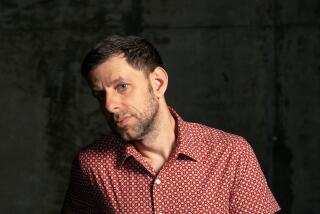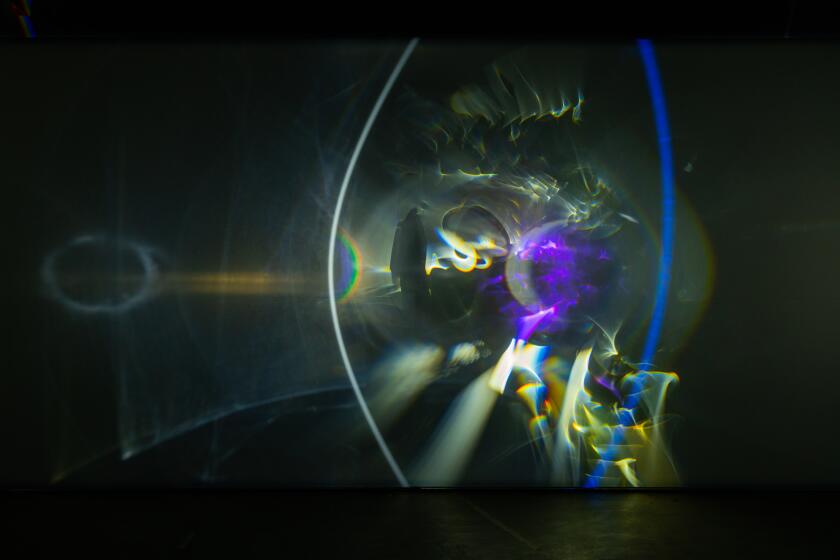Drama afoot as L.A. Opera feels heat of rival works
This spring, opera in Los Angeles has been winning praise for its daring and diversity. A boldly abstract version of “Don Giovanni” staged by the Los Angeles Philharmonic. An edgy multimedia opera, “Crescent City,” presented by The Industry.
Coming up: Benjamin Britten’s “Curlew River,” by the innovative music group Jacaranda, and a new chamber opera, “The Face,” by two USC scholars.
This operatic blossoming has been good for local audiences, but it has raised awkward questions and touched a sensitive nerve in the city’s arts community.
That’s because none of those productions belongs to Los Angeles Opera, which for a quarter-century has been the city’s only full-time opera company. And one of them is a production from its colleague across the street, the L.A. Phil, which has been collecting accolades and new fans since the arrival of Gustavo Dudamel in 2009.
Earlier this year, several members of L.A. Opera’s board of directors were dismayed when the L.A. Phil announced its upcoming 2012-13 season. The orchestra’s schedule includes “The Marriage of Figaro,” the second of its planned trilogy of Mozart operas; “Where the Wild Things Are,”Oliver Knussen’s one-act opera based on Maurice Sendak’s classic children’s book; and the West Coast premiere of Peter Eötvös’ opera “Angels in America.”
It will also present a fully staged production of John Adams’ new oratorio-opera “The Gospel According to the Other Mary,” an L.A. Phil commission that just premiered in concert version. The orchestra’s official announcement heralded its opera performances as among next season’s highlights.
One L.A. Opera board member, Leslie Dorman, wrote a letter to L.A. Phil President Deborah Borda to express her displeasure, sources confirmed. Reached by phone, Dorman declined to comment. But Carol Henry, L.A. Opera’s board president, acknowledged the board members’ concerns.
“The problem was a lack of communication in the beginning, and how extensively the Philharmonic is doing opera, and doing the Da Ponte cycle,” Henry said, referring to the three operas that Mozart wrote with librettist Lorenzo Da Ponte. “I didn’t realize how extensive it was going to be.”
L.A. Opera and L.A. Phil administrators insist there’s no conflict between their institutions, which are neighbors on downtown’s Grand Avenue and have a long history of cooperation and collaboration, they said.
“Do I think that the L.A. Phil is a competitor? No, because it’s apples and oranges, we’re doing something completely different,” said Christopher Koelsch, L.A. Opera’s senior vice president and chief operating officer.
But the dust-up underscores a more delicate issue: the perception that organizations such as the L.A. Phil, Long Beach Opera, and The Industry, a new company, are upstaging L.A. Opera by doing more inventive productions of opera and opera-like music theater.
“They [L.A. Opera] are fossilized. They’re depending on these old war horses and their aging audience. And they don’t even do productions that are that new in approach,” said Anne LeBaron, the composer of “Crescent City” and a faculty member at the California Institute of the Arts.
“For them to go ballistic because the Phil decides they’re going to do some opera — maybe it’s a wake-up call,” LeBaron said.
L.A. Opera officials said the board members who raised concerns didn’t understand that the opera company was well aware of the Phil’s plans and fully supports them. (L.A. Opera will present its own version of “Don Giovanni” this fall.)
Stephen Rountree, L.A. Opera’s chief executive, said that he and board Chairman Marc I. Stern were taken aback by the uproar. “My reaction and Marc’s reaction was, Jesus, you know, we have four or five people here that are just stirring the pot unnecessarily and we need to calm this down. They need to understand the broader context.”
Rountree said that he, Stern and Plácido Domingo, the superstar tenor who serves as L.A. Opera’s general director, “didn’t make an effort to really inform our board two years ago about the Phil’s upcoming Mozart/Da Ponte series” because “we had just taken it as a matter of course.”
Members of both organizations said the matter is now behind them. Nonetheless, L.A. Opera and the L.A. Phil recently formalized an agreement under which officials of the two companies will meet four times annually to share schedules so as to avoid programming overlap and discuss more ways to collaborate artistically.
Henry, the opera board president, said the institutions also agreed that the 93-year-old Phil from now on will concentrate on modern operas, and will lean toward concert versions rather than staged or semi-staged productions.
“The conflict is with the administration side of things, not the artistic side,” Henry said. “The Philharmonic has always been the big sister on the block, and the little sister is growing up.”
The Phil’s Borda confirmed the new arrangement but said that “there’s no specific agreement” on what sort of operatic repertoire the L.A. Phil will do in the future. “We will discuss it and come to mutual agreement,” she said.
The L.A. Phil’s interest in opera, which it has been performing for years, is hardly exceptional among orchestras. Marc Scorca, president and chief executive of the service organization Opera America, said U.S. symphonies are performing more opera than ever before.
“They do it because opera sells,” Scorca said. “Symphonies dealing with diminished attendance are trying to diversify their programming to attract new and different audiences.”
Jesse Rosen, president and chief executive of the League of American Orchestras, concurred. “I would speculate that it may have to do with the theatrical aspect of opera. The visual component of opera is a compelling one.”
L.A. Opera is emerging from a difficult period. Partly due to financial problems stemming from Achim Freyer’s critically praised avant-garde production of Richard Wagner’s “Ring” cycle a few years ago, the company has had to cut back its productions and performances in recent seasons. In 2009 the company received a $14-million emergency loan from Los Angeles County. It has since repaid half and expects to pay the rest later this year.
The company has not presented a new opera on its mainstage since premiering Daniel Catán’s “Il Postino” in fall 2010. Its most recent offering was a nearly sold-out re-mounting of Herb Ross’ 1993 production of “La Boheme.”
But L.A. Opera officials insist they are not retreating. In April came the announcement of the launching of a subsidiary brand, L.A. Opera Off Grand, designed to help the company serve a broader geographical area, increase audience diversity and broaden its offerings by working with composers, designers and other artists who are relatively new to opera.
“I think our legacy of programming has been as bold as any company in the United States,” Koelsch said.
Meanwhile, an increasing number of local music groups are trying to lure audiences eager for new operatic experiences. Among them is Santa Monica-based Jacaranda: Music at the Edge, whose production of Britten’s 70-minute “Curlew River” will be staged by Yuval Sharon, founding director of The Industry. Sharon first came to Los Angeles while serving as assistant director on Freyer’s “Ring” cycle.
“I understand the financial challenges that L.A. Opera has, especially with the debt incurred by the ‘Ring’ cycle, which I personally thought was absolutely brilliant,” said Patrick Scott, Jacaranda’s artistic director. “But I think that they have had a history of making safe choices.”
“I know it’s a fine line,” Scott continued, “but I feel like if they don’t start to swing out, and do the kind of repertoire that [has] legs with the audience, they’re painting themselves into a corner.”
More to Read
The biggest entertainment stories
Get our big stories about Hollywood, film, television, music, arts, culture and more right in your inbox as soon as they publish.
You may occasionally receive promotional content from the Los Angeles Times.












